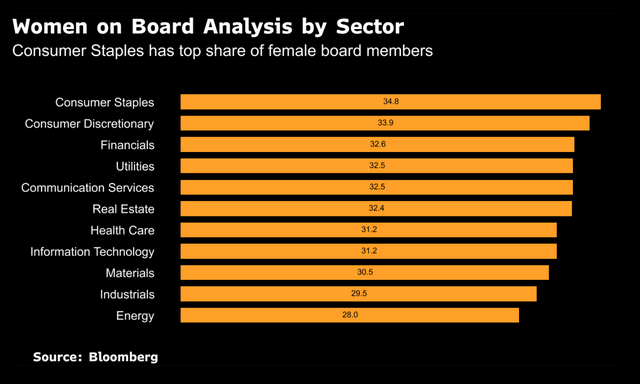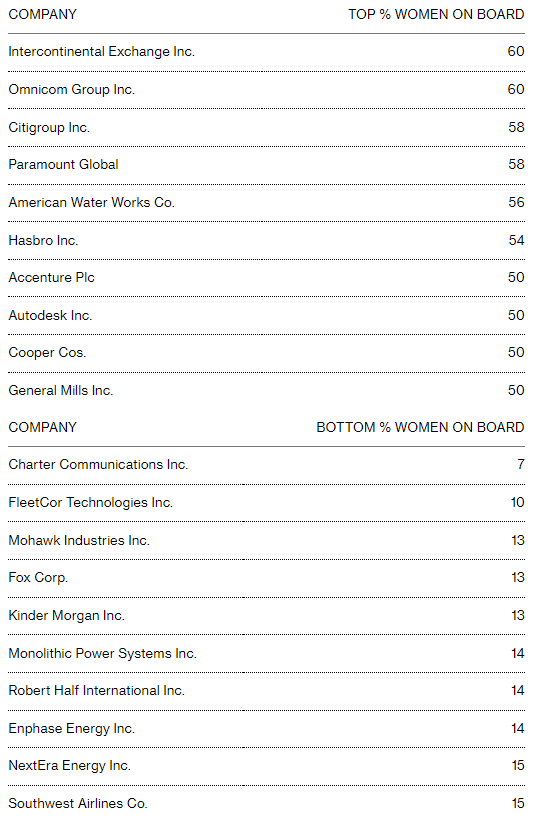Boyden's Keith Dorsey shares his thoughts on the shift to gender parity for women as it relates to board seats

Written by Jeff Green. This article was originally published by Bloomberg. Click here to view the original article.
➤ For first time since 2019, women’s share of boardroom dropped
➤ Women held six fewer board seats in June than they did in May
Women lost ground in S&P 500 boardrooms for only the second time in the past three years.
The June decline of about a decimal point, which rounds to 31.7% from 31.8% in May, was the first such slide since August 2019. Women held six fewer seats on the boards of companies in the S&P 500 last month, the second consecutive month of declines, data compiled by Bloomberg show.
“We need to build a better pipeline of women in the right roles,” said Jane Stevenson, vice chair at recruiter Korn Ferry.
Companies face less pressure these days to add women to boards, having reached what activists have long said was “critical mass” of 30%, the level at which women are seen as having more influence on decision making. After the murder of George Floyd by police in 2020 raised new concerns about racial inequities, there’s been additional motivation to select directors of color, Stevenson said.
The focus on racial equity has slowed progress for women because in some cases that means an under-represented man is chosen over a female candidate, she said.
“As difficult as it’s been relative to women in the boardroom, it’s been even more difficult relative to color in the boardroom,” Stevenson said.
There also remains a pipeline problem because there aren’t enough women running corporate units who might be eligible to serve on a board. And even when there is an executive who has operating experience, the company she works for can still block her from serving on a board.
Stevenson cited an example this week of a woman of color who was the top choice for an open board seat, but her company was unable to allow her to serve because of an ongoing reorganization. The board who wanted to appoint her may circle back next year to see if the situation has changed, Stevenson said, declining to identify the company.
Similarly, the number of female directors at companies in the S&P 500 Banks Index, a subset of the S&P 500, was unchanged in June for the fourth straight month, the longest dry spell since Bloomberg started the monthly tracker in January 2019.
Still, the proportion of women on bank boards averages about 35% of the seats. That compares with less than 20% for most US companies as recently as 2015, according to an annual study from recruiter Spencer Stuart.
The focus is now shifting to gender parity for women, who already make up half the workforce, but it will take time, said Keith Dorsey, a member of executive recruiter Boyden’s global board and chief executive officer practice. Companies that had set a goal of 30% now have to shoot higher and get business leaders to do the same, he said.
As an example, the group 20/20 Women on Boards, which had sought to get women in the Russell 3000 stock index to 20%, has been renamed 50/50 Women on boards. Other groups are now saying women should have no fewer than 30% of board seats, Dorsey said.
“There needs to be a change in the thinking in the marketplace that 30% is a good place to start, but there’s so much more to be done,” he said.
The net loss of six seats in June followed the net drop of nine seats in May, the first two-month slide since Bloomberg started tracking the data in January 2019. In all, women held 1,731 of the 5,452 seats among S&P 500 boards at the end of June, Bloomberg data show.

In June, the average number of female directors serving on S&P 500 corporate boards was unchanged at 3.5, out of an average board size of 10.9.
- The percentage of female directorships decreased to 31.7% from 31.8%.
- That compares with 14.2% for companies in Japan’s Nikkei 225, 16.4% for companies Hong Kong’s Hang Seng index, 35.3% for companies in Australia’s S&P/ASX 200 and 38.9% for companies in Europe’s Stoxx 600 index.
- Twelve S&P 500 companies increased the number of women on their boards, includng Chevron Corp., Medtronic Plc and Lowe’s Cos.
- Sixteen companies reduced the number of female directors, including UnitedHealth Group Inc., Comcast Corp. and NextEra Energy Inc.
- Intercontinental Exchange Inc. and Omnicom Group Inc. have the highest percentage of women on their boards
- Charter Communications Inc. has the lowest percentage of women on its board.
- The energy sector led the net gain in female board members, with one woman added to Chevron’s board.
- The health-care industry notched a net decline of four female directors, with UnitedHealth, Biogen Inc. and Incyte Corp. losing female board members.
- T-Mobile US Inc., Medtronic and Xcel Energy Inc. surpassed 30% of female board membership for the first time since at least January 2019.
- The Bloomberg Gender-Equality Index dropped 9.8% in June, more than the 8.6% slide of the MSCI World Index.
S&P 500 companies with the highest and lowest percentage of female board members:

The analysis is based on data that covers 498 companies in the S&P 500. Historical analysis may be impacted by changes to the index membership, while monthly board changes may be considered effective at month’s end.
The Bloomberg Gender-Equality Index is a modified capitalization-weighted index that tracks the financial performance of those companies committed to supporting gender equality through policy development, representation and transparency.
To see the percentage of women on a company board, click {FA ESGG <GO>}; to see more on the Bloomberg Gender-Equality Index, click {GEI <GO>}.
To see the percentage of female directors for each of the S&P 500 companies, click {SPX Index GX <GO>}. In search box on top right, choose “% Women on Board.” Mouse over to get each company’s results.
To see more on Bloomberg’s ESG fields and sustainable finance solutions, click {BESG <GO>}.

